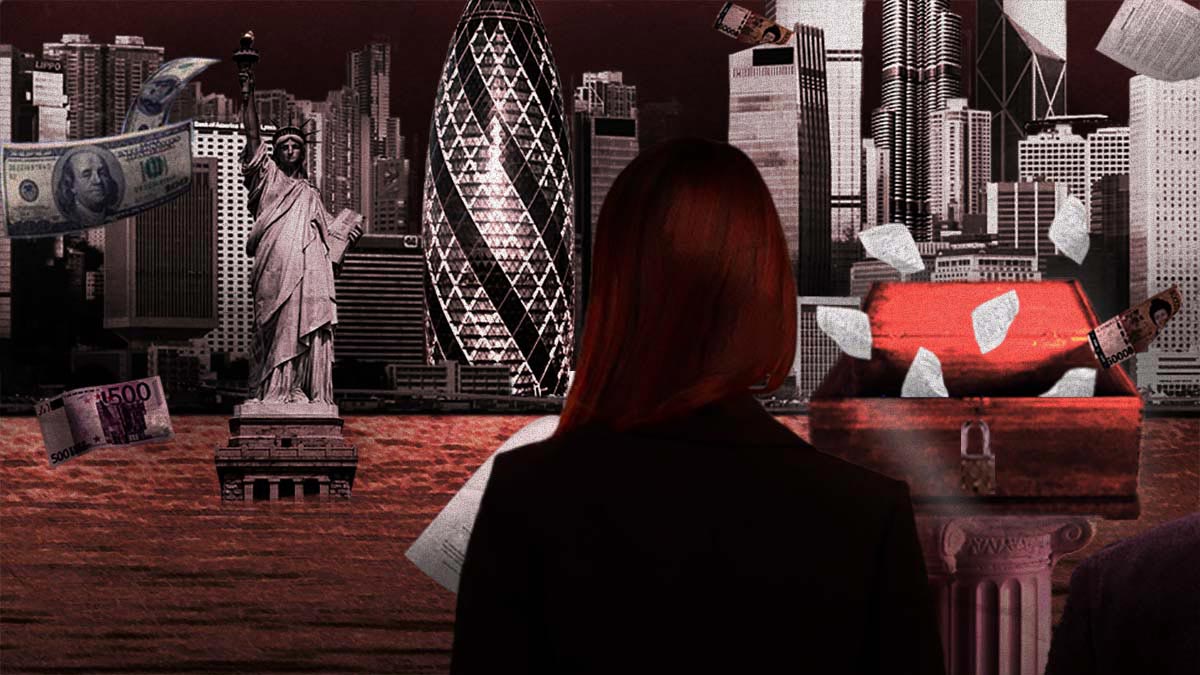Will ICIJ publish the Pandora Papers data? What’s the difference between Pandora and Panama Papers? We answer some of the most frequently-asked questions about our investigation.

Since the publication of the first stories from our Pandora Papers investigation on Oct. 3, the International Consortium of Investigative Journalists has been contacted by members of the public and press with questions about the data, the project, and more. Here, we answer some of the most frequently-asked questions. We may update this post from time to time.
What are the Pandora Papers?
The Pandora Papers is an investigation into the shadowy offshore financial system that reveals the workings of a secret economy that benefits the wealthy and well-connected at the expense of everyone else.
The “papers” are the more than 11.9 million confidential records obtained by the International Consortium of Investigative Journalists that form the backbone of the investigation.
Where did the Pandora Papers leak come from?
The records come from 14 offshore service providers — law firms, wealth management advisors and corporate formation agencies — that help those with money set up companies in low- or no-tax jurisdictions. You can find out more about the firms here.
Who was the source of the Pandora Papers?
ICIJ does not comment on its sources. ICIJ did not pay for the data and no conditions were attached to it being shared. ICIJ does perform rigorous verification and cross-checking of data to ensure its authenticity and verifies every fact published in our stories.
Why is it called “Pandora” Papers? . . .
We called the project Pandora Papers because the investigation builds upon previous ICIJ-led collaborations , the Panama and Paradise Papers; the ancient myth of Pandora’s Box evokes an outpouring of trouble and woe.
What’s the difference between Pandora Papers and Panama Papers?
Size, scale, scope. While the Panama Papers was based on the files of a single offshore services provider, the Pandora Papers records come from 14. The new investigation includes data on more than 27,000 companies and 29,000 so-called ultimate beneficial owners — the real owners of shell companies — or more than twice the number of beneficial owners identified in the Panama Papers. The Pandora Papers also connected offshore activity to more than twice as many politicians and public officials as did the Panama Papers.
Why does the Pandora Papers investigation matter?
The offshore system allows elites and multinationals to shift taxable wealth to paper-only companies in low-tax jurisdictions, without requiring them to live or actually earn profits there. They can shelter their assets— yachts, airplanes, artwork, mansions, cash and even company shares — by paying financial services providers to set up companies to hold those items. It also offers secrecy, which provides an opportunity to hide assets from authorities, creditors and other claimants as well as from public scrutiny.
The offshore financial system can drain trillions of dollars from treasuries, worsen wealth disparities and protect those who cheat and steal while depriving their victims of recourse. Studies have estimated that the world’s ultra-wealthy own the bulk of the $11 trillion realm of offshore companies.
What is “offshore”? What are tax havens?
There is no universal definition, but offshore tax havens, or offshore financial centers, are generally countries or places with low or no corporate taxes that allow outsiders to easily set up businesses there. Tax havens also typically limit public disclosure about companies and their owners. Because information can be hard to extract, tax havens are sometimes also called secrecy jurisdictions. Financial secrecy is commonly associated with small island territories like the British Virgin Islands or the Cayman Islands, which help shelter wealth from all around the world — hence the “offshore” moniker. But in practice, and as the Pandora Papers and other investigations show, any jurisdiction can offer the same secrecy or tax status on foreign-owned entities — from South Dakota to London to Hong Kong. Tax havens nearly always deny being tax havens. Read more about tax havens, shell companies and the offshore industry in our explainer, or watch this video from our original Offshore Leaks investigation.
How do the Pandora Papers compare in size with other huge offshore leaks?
In terms of raw size, the Pandora Papers leak, at 2.94 terabytes, is bigger than both Panama Papers (2.6 terabytes) and Paradise Papers (1.4 terabytes). If you go by the number of files, the Paradise Papers had more — 13.4 million files, compared to Pandora’s 11.9 million.
But there’s more to this leak than just size. The scope of Pandora Papers is far broader than anything ICIJ and its partners have seen before. The leak comes from 14 different offshore service providers and includes far more beneficial ownership information and politicians and public officials than any previous leak.
What sort of files were in the Pandora Papers leak?
The 2.94 terabytes of records, which arrived as PDFs, images, emails, spreadsheets, audio and video files, includes company incorporation records, real estate contracts, due-diligence questionnaires, copies of passports, bank statements, tax declarations, and much more.
Who was named in the Pandora Papers leak?
The files reveal financial secrets of 35 current and former world leaders. They are among the more than 330 politicians and high-level public officials in 91 countries and territories, and a global lineup of fugitives, con artists and murderers.
Reported here are offshore dealings of the King of Jordan, the presidents of Ukraine, Kenya and Ecuador, the prime minister of the Czech Republic and former British Prime Minister Tony Blair. The files also detail financial activities of Russian President Vladimir Putin’s “unofficial minister of propaganda” and more than 130 billionaires from 45 countries, including Russia, the United States and other nations, as well as 46 Russian oligarchs, bankers, big political donors, arms dealers, international criminals, pop stars, spy chiefs and sporting giants.
People linked by the secret documents to offshore assets include India’s cricket superstar Sachin Tendulkar, pop music diva Shakira, supermodel Claudia Schiffer and an Italian mobster known as “Lell the Fat One.”
In addition to the end-users, there’s also a line-up of professional enablers — lawyers, advisers, trust fund managers, and more — who help drive the system.
Why so many world leaders and politicians?
Call it the luck of the leak. The providers in the Pandora Papers, in particular Alcogal and Trident Trust, happened to serve a large number of current and former politicians and public officials as clients (with most of their companies registered in the British Virgin Islands and Panama). Alcogal clients alone represent nearly half of the politicians and public officials identified in the Pandora Papers.
Why can’t I find a list of the 336 politicians?
We profiled 60 of the biggest political names in the data in our Power Players feature. To have listed all of them would have required more resources than ICIJ has, particularly in approaching subjects with requests for comment. In fact, there are likely more political figures in the documents than 336 but the published figure represents those that passed our (rigorous) verification criteria. The internal list is available to our media partners who can use it to generate leads for future stories.









Δεν υπάρχουν σχόλια:
Δημοσίευση σχολίου
To μπλόκ " Στοχσμός-Πολιτική" είναι υπεύθυνο μόνο για τα δικά του σχόλια κι όχι για αυτά των αναγνωστών του...Eπίσης δεν υιοθετεί απόψεις από καταγγελίες και σχόλια αναγνωστών καθώς και άρθρα που το περιεχόμενο τους προέρχεται από άλλες σελίδες και αναδημοσιεύονται στον παρόντα ιστότοπο και ως εκ τούτου δεν φέρει οποιασδήποτε φύσεως ευθύνη.